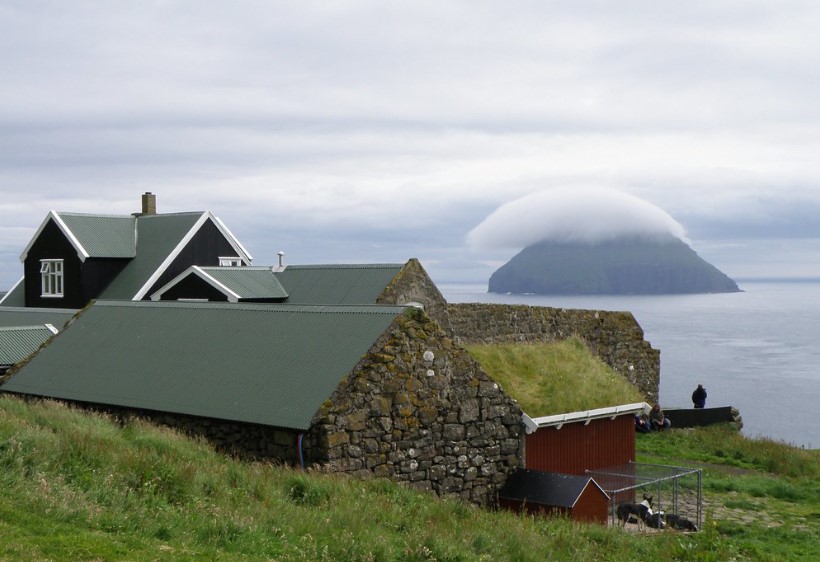Lítla Dímun is a tiny and secluded island located between Suðuroy and Stóra Dímun in the Faroe Islands. It stands out as the smallest of the 18 main islands and is unique in that it is uninhabited. The island’s name, meaning “Little Dímun,” contrasts with that of Stóra Dímun, which translates to “Great Dímun.”
The island’s name may have originated from a pre-Norse, Celtic term meaning “double-neck,” as suggested by Fridtjof Nansen. The pairing of Stora and Litla Dímun represents two separate localities with distinct features. According to Gammeltoft, Dímun’s name may reflect linguistic interaction between Scandinavians and Gaels.
Lítla Dímun features a sheer cliff face along the lower third of the island and the rest is comprised of the mountainous Slættirnir, reaching a height of 414 meters. The island is only home to Faroe sheep and various seabirds, making it an Important Bird Area as designated by BirdLife International.
The uninhabited island is a significant breeding ground for European storm petrels, with 5000 pairs, and Atlantic puffins, with 10,000 pairs. Getting to the island can be challenging and is only possible under favorable weather conditions. Climbing the cliffs requires the use of ropes placed by the sheep owners. The island is void of any other land animals besides sheep.

The history of Lítla Dímun dates back to ancient times when sheep were kept on the island, as mentioned in the 13th-century Færeyinga Saga. The saga also depicts the island as the site of a battle between Brestur and Gøtuskeggjar, resulting in the death of Brestur and his men and the deportation of his son, Sigmund, to Norway. While in Norway, Sigmund became friends with Olaf Tryggvasson, the King of Norway from 995 to 1000.
The island was once owned by the Danish King, but it was difficult to find anyone willing to settle there due to its steep and challenging landing conditions. Thus, it was decided to sell the island, and the auction was held in Hvalba on July 24, 1852. Men from Hvalba and Sandvík outbid the Factor for the royal sales station in Tvøroyri, making the final bid of 4,820 Rigsdaler or 9,640 Dkk, which was considered a substantial sum at the time.
The uninhabited island was then granted to the men from Hvalba and Sandvík as Copyhold inheritance, in exchange for 40 Dkk in copyhold rent and 10 Dkk every time there was a new owner. In 1911, the money was released with 1,000 Dkk, making Lítla Dímun the only privately owned island in the Faroe Islands.

In 1918, the Danish schooner Caspe met with disaster when it was forced onto Lítla Dímun by a raging gale. The six crew members managed to reach a narrow ledge above the waves, but they were without supplies and the captain was badly hurt. Eventually, they managed to move from the ledge and stumbled upon a cabin with matches, fuel, and a lamp. They managed to catch two sheep and a sick bird and were able to survive for 17 days until they were rescued by a fishing boat. One of the sailors who survived the shipwreck eventually made a home in the Faroe Islands.
The current population of sheep on Lítla Dímun is Faroes sheep, but in the mid-19th century, the island was home to wild sheep. These sheep were likely descended from the first sheep that were brought to Northern Europe in the Neolithic period and had a black, short-wooled appearance similar to the Soay sheep of the St Kilda archipelago in Scotland. In the 1860s, the last of these feral sheep were hunted.
Every autumn, the modern Faroe sheep on the island are rounded up. A fishing boat sails to the island and tows several rowing skiffs. A group of about 40 people then form a line across the island, herding the approximately 200 sheep into a pen on the north side of the island. The sheep are then captured, tied up, put into nets of five, and lowered by ropes into the skiffs.
Each skiff transports its load of 15 sheep back to the fishing boat, which returns to the island of Suðuroy. Once the sheep are unloaded in the village of Hvalba, they are lined up and distributed to their owners. Some sheep manage to escape the annual gathering and may be hunted in the future. In the book trilogy “Cyboria” by Pierdomenico Baccalario, a futuristic utopia called New City is located on this island and hidden by clouds to remain undetected in the sky.







